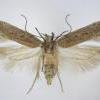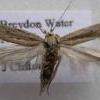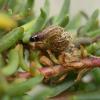35.112 Scrobipalpa suaedella (Richardson, 1893)
Status and Distribution
Very local, occasionally locally common.
Found in coastal saltmarshes along the south and east coast of England from Dorset to Norfolk. The distribution is patchy in south east England with few records from Sussex and none from Kent. There is a single 1962 record from Jersey.
Provisional map
Foodplant and Larval Feeding Signs
Suaeda vera (shrubby sea-blite), see plant distribution map, or occasionally on Suaeda maritima (anual sea-blite).
In a silken gallery amongst the leaves and blossom.
Habitat
Coastal saltmarshes.
Finding the Moth
Larva: in a silken gallery amongst the leaves and blossom generally at the tips of the shoots, occasionally on two shoots which are spun together. Infested shoots become withered and turn brown. Most larvae have been found from late April to mid-June but it has been recorded on annual sea-blite in August, a plant that is hardly visible in May and June.
Adult: comes readily to light.
Similar Species
One of the more readily identifiable Scrobipalpa in its usual British form with an unmarked pale ochreous dorsal quarter to the forewing. The species can on occasions be quite variable when it may superficially resemble Scrobipalpa instabilella, S. nitentella, S. samadensis or S. salcorniae (formerly in the British Isles thought to be S. salinella). S. ocellatella can also have a clear pale area at the base of the forewing but the central blackish spots are small and usually surrounded by a paler ring of colour. In S. suaedella these spots are variable and may resemble short black streaks, it does do not have an obvious ring of pale colour around these marks and lacks the warm brown patch from before the tornus to the middle of the wing. Dissection is recommended if there is any doubt.
Single brooded from mid-June to early September.
Earliest: 3rd June 2007 (VC9)
Latest: 19th September 2009 (VC19)




